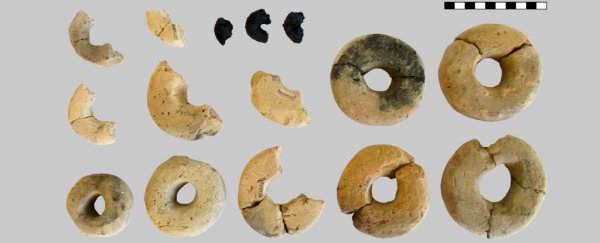Starting the day with a bowl of pressed cereal rings from a garish cardboard box is a signature of the modern age. So when researchers discovered that a stash of tiny, Bronze Age doughnuts were made from processed grains, they seemed strangely out of place.
The Austrian archaeological dig site of Stillfried an der March was once a prominent settlement in the 9th to 10th centuries BCE, during what's known as Central Europe's Late Urnfield period.
In the 1970s and 80s researchers stumbled across dozens of variously sized pits scattered evenly around the site; on closer inspection, it became clear these sites were used to store grain.
Strangely, that's not all they held. If you thought your cereal boxes came with some weird prizes, two of these underground grain silos came with human skulls. Another contained seven dead bodies.
There was a variety of other decidedly 'odd' objects in some other holes, among them 14 clay rings and ring sections roughly 6 to 10 centimetres (2.3 to 4 inches) in diameter. The markings on the loosely fired ceramics suggested they were probably used as weights for a loom.
Weirder yet were the three charred chunks of curved organic material roughly 2.6 to 3.6 centimetres (1 to 1.5 inches) across found among them, likely to have been complete rings once, too.
It appeared that the materials were carefully deposited in the bottom of the pit at the same time, meaning they hadn't simply trickled in piece by piece or been dumped in as rubbish.
To work out their exact make-up, and maybe determine their purpose, researchers carried out a series of tests that included radiocarbon dating and scanning electron microscopy.
We now know these tiny ring fragments were a dough made from a fine flour of hulled barley and wheat. Without signs of being baked, it's most likely they were simply moulded from a wet mixture and then left to dry.
Their date of production was also narrowed down to a tiny window of 960 to 900 BCE.
It's not that we should be surprised that farming communities of such a period might be eating grain that's been ground, pulverised, turned to mush and dried. Fragments of processed cereals tend to decay easily, but they're not unknown to archaeologists.
But these tiny half-circles are quite unlike anything researchers have seen before. Their creation wouldn't exactly be the most time-efficient method for making consumables in the Bronze Age either.
"Their finely ground flour and intentional shaping certainly indicate that more time was invested in their production than necessary for subsistence," the researchers note in their report.
"The rings may therefore have been of higher value than the other cereal preparations described from Stillfried."
Given the 2,000 year old Cheerios happen to resemble the loom weights they were buried with, it's easy to speculate they weren't made to be eaten, but had perhaps a more ritualistic purpose.
Exactly what that purpose could be is a complete mystery.
Finding similar objects in other Bronze Age sites might help shed some light on whether they have a supernatural or practical application. We shouldn't hold our breath, given the fragility of such food items - but it's a fascinating mystery to puzzle over nonetheless.
This research was published in PLOS One.
